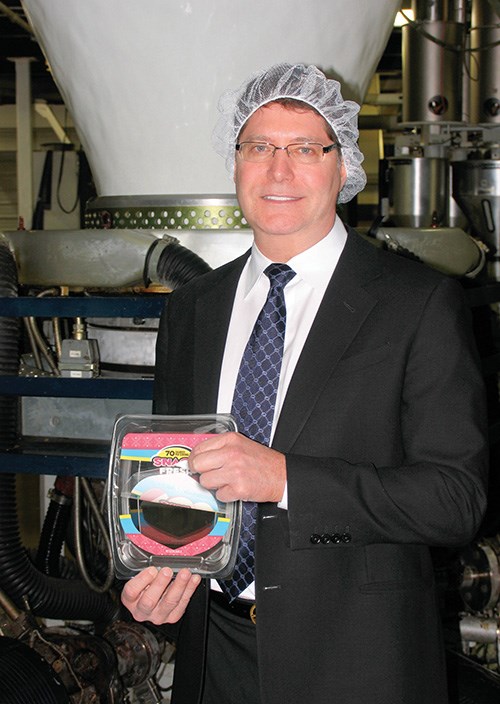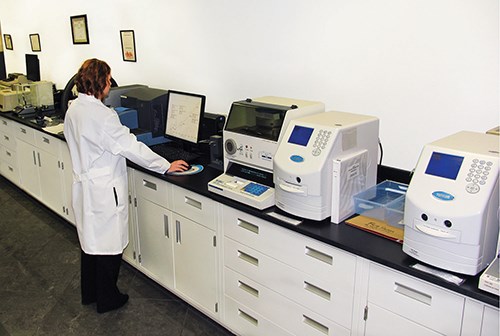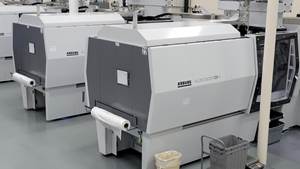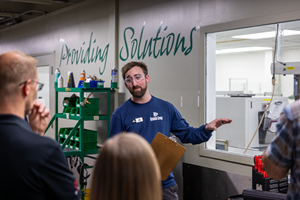Packaging Powerhouse Does It All
On Site: Clear Lam
Materials formulation, cast and blown film extrusion, sheet extrusion, printing, and laminating come under one roof at this processor.
From humble beginnings to an innovative, global packaging powerhouse that despite its size and scope has still managed to maintain an entrepreneurial spirit: That’s the story of Clear Lam Packaging, where materials formulation, cast and blown film extrusion, sheet extrusion, printing, and laminating come under one roof in the Chicago suburb of Elk Grove Village, Ill.
It’s a pretty big roof, too, encompassing more than 500,000 ft², under which more than 500 people work in development of novel flexible and rigid structures, primarily for food markets. The business operates two facilities in Elk Grove Village, Ill., and one in Nanjing, China. And after spinning off a rather sizeable thermoforming operation last May, Clear Lam’s plans are to grow even larger in film and sheet.
James Sanfilippo, Clear Lam’s president and COO, runs the business with a self-described “hands-on” approach to driving innovation and improving customer value: “What we strive for in everything we do is to add value and offer products with unique properties that give our clients the edge in the marketplace.”
Clear Lam started in 1969 as a small operation producing film for snack food packaging. In the early 1970s it added capabilities—film structures and equipment—to make cellophane-based lidding for portion control packaging. Then in the late 1990s it merged a modified atmosphere packaging (MAP) equipment business into the organization. That equipment business was ultimately sold off in 2007, but high-barrier packaging and lidding remain a specialty at Clear Lam and the center of lots of innovation, notes Sanfilippo.
Last year, for instance, Clear Lam unveiled new Peel and ReSeal Lidding Film, a single structure that replaces the two-piece rigid lid with a shrink band around it. The film opens easily and reseals to the package with a light touch. Compared with containers having a rigid lid, the Peel and ReSeal Lidding Film reduces weight by as much as 30%, improves shipping cube, and provides an enhanced safety seal. The film is said to be suited to deli, bakery, produce, and a host of other applications.
“For most food processors and retailers today, sustainability has become not just an option, but a normal course of doing business,” states Sanfilippo. “This is translating into growing demand for packaging solutions that help companies meet their sustainability goals while providing improved efficiencies and cost advantages.”
Sanfilippo continues: “Today’s consumer is more sophisticated and price sensitive, so any packaging improvement must provide tangible benefits. That’s why Clear Lam’s focus is on developing packaging that addresses real consumer needs while meeting our customer’s long-term sustainability initiatives.”
This lidding film is part of another Clear Lam innovation that might turn out to be a game changer in packaging. Late last year, the company took the wraps off the PrimaPak package. Several years in development and the result of millions of dollars in R&D, PrimaPak is a flexible, stackable, reclosable package designed to replace cans, bottles, and jars.
The PrimaPak structure consists of a proprietary multi-layer blown film that is laminated to several undisclosed substrates to build in heat resistance, then processed on vertical form-fill-seal (FFS) equipment from rollstock. The package is engineered to maximize manufacturing, warehousing, cubing, shipping, and merchandising efficiencies, Sanfilippo says.
“PrimaPak can be 70% lighter than the blow molded package it could replace,” Sanfilippo says. “That’s a significant reduction is material usage. It’s square or rectangular in shape, which improves cube. And the fact that is has six sides (including the top and bottom) gives brand owners more space to communicate their message.”
Initial target applications are nuts and other snack foods. “For nuts, we’ve estimated that switching to PrimaPak from current packaging applications will eliminate 10 million lb of trash from the waste stream.” Clear Lam currently holds six patents on the product, with another half-dozen pending.
More innovation is on the way, says Sanfilippo—in particular, mechanical closing of the lidstock. The technology is sold as part of a system that also includes FFS equipment designed and engineered by Clear Lam.
FOUR DIVISIONS
Clear Lam’s business is broken into four units. Its flexible films division is supported by three- and five-layer coextrusion lines furnished by Hosokawa Alpine America, Natick, Mass., and Reifenhauser-Kiefel, Danvers, Mass., respectively. Films range from ultra-high-barrier to breathable structures in peelable or permanent-seal formats for cheese, salty snacks, meats, condiments, liquids, prepared meals, meal kits, and produce. In non-food categories, the films package personal healthcare products, detergents, wet naps, electronics, toys, and other industrial goods.
Both lines utilize the latest in gravimetric blending technology, dosing up to 10 different ingredients to the extruders. The three-layer line runs at 1500 lb/hr, the five-layer line at about 1000 lb/hr. Both use Wintech winders from Reifenhauser Kiefel to make film rolls up to 120-in. wide and 42 in. diam.
Clear Lam runs flexographic and rotogravure printing presses with up to 10 colors. It has solvent, solventless, and water-based laminators, and large-scale slitting capacity. Its solvent-free laminators were developed in-house to run at speeds up to 1000 ft/min. Printing plates are made in an in-house graphics department.
Clear Lam is currently in the midst of a $20 million capital-equipment investment plan. It just recently added its fourth high-speed printing press from Windmoeller & Hoelscher, Lincoln, R.I., as well as additional laminating capacity, and is looking at expanding into nine-layer film extrusion.
Clear Lam also recently added technology to laser-score and perforate films, a technology that allows for easy opening but, perhaps more importantly, greater control over respiration rates for produce. “Up to 80% of our applications are self-developed,” Sanfilippo states. “We identify a need in the marketplace and work to develop a solution.”
Clear Lam has an extensive polymer-science lab in Elk Grove Village with the full gamut of testing equipment. This includes machinery for testing oxygen and water-vapor transmission, coefficient of friction, bond strength, film composition, hot tack, impact, aroma, and much more.”
Clear Lam’s forming films division supplies rigid cast film and sheet rollstock to thermoformers, food processors, and custom manufacturers supplying food, personal healthcare products, electronics, and industrial goods. A three-layer A-B-A line from Welex, Blue Bell, Pa., processes PET/RPET, PLA, and PS for food, electronics, personal healthcare, and industrial goods. In addition, numerous custom laminations include EVOH for enhanced oxygen barrier and polyethylene for hermetic sealing. In the fourth quarter of last year, the company expanded its forming films division through a $2 million investment, adding a new sheet coextrusion line that will provide 15 million lb/yr of additional capacity.
In 2009, Clear Lam worked with Stonyfield Farm to convert its yogurt cups from PS to PLA sheet. The PLA sheet was more than 25% thinner than the PS structure it replaced, but the cups were stronger, broke less, and provided better lid adhesion and lower processing temperatures, which save energy. In addition, Clear Lam developed a new generation of innovative barrier structures produced from 80% renewable raw materials. These products allow food processors to reduce the use of petroleum-based plastics without compromising performance.
These new plant-based materials are part of Clear Lam’s Project EarthClear Initiative. They are used on FFS machines to package such items as pastas, egg rolls, sliced meats, burritos, and other prepared foods. Project EarthClear (projectearthclear.com) was launched by Clear Lam in 2005. Its purpose is to foster development of materials and packaging designs that minimize impact on the environment. It focuses on three main areas:
•Packaging made from renewable raw materials as opposed to oil;
•Packaging made with some form of recycled plastic or paper;
•Lightweighting designs and technologies.
“We believe we have a moral obligation to have good, sound, sustainable offerings with a small environmental footprint,” Sanfilippo comments. To that end, Clear Lam last year signed an agreement with Toyota Tsusho Corp. making it the first North American processor to offer the Bio-PET product in rollstock form. Bio-PET materials are similar to Coca-Cola’s PlantBottle in utilizing plant-derived monoethylene glycol in the PET polymerization. The resulting PET is 30% renewably based.
Much of Clear Lam’s success in formulating unique extruded products can be attributed to another unit, the CL Polymers division. There, utilizing twin-screw extruders developed in-house, the unit provides specialty compounds both for internal consumption and sale to outside extrusion operations and injection and blow molders.
A major focus in the division is custom compounded additives for bioplastics to improve extrusion performance, impact resistance, and cutting characteristics. “Our materials development know-how has helped us in our PLA platform,” says Sanfilippo. “We’ll visit a customer plant, trial different materials, and do whatever R&D is required until we come up with a solution that works better than what the customer currently is using.” For applications requiring RPET, CL Polymers offers additives that enhance the impact resistance at various temperatures without significantly effecting clarity.
In addition to its position in the Chicago area, Clear Lam has a wholly owned subsidiary in China, Clear Lam Flexible Films (Nanjing) Co. Ltd. The 80,000 ft² facility manufactures laminated, coated, and printed films.
Related Content
For Extrusion and Injection-Blow Molders, Numerous Upgrades in Machines and Services
Uniloy is revising its machinery lines across the board and strengthening after-sales services in tooling maintenance, spare parts and tech service.
Read MoreConsistent Shots for Consistent Shots
An integral supplier in the effort to fast-track COVID-19 vaccine deployment, Retractable Technologies turned to Arburg and its PressurePilot technology to help deliver more than 500 million syringes during the pandemic.
Read MorePHA Compound Molded into “World’s First” Biodegradable Bottle Closures
Beyond Plastic and partners have created a certified biodegradable PHA compound that can be injection molded into 38-mm closures in a sub 6-second cycle from a multicavity hot runner tool.
Read MoreMedical Molder, Moldmaker Embraces Continuous Improvement
True to the adjective in its name, Dynamic Group has been characterized by constant change, activity and progress over its nearly five decades as a medical molder and moldmaker.
Read MoreRead Next
People 4.0 – How to Get Buy-In from Your Staff for Industry 4.0 Systems
Implementing a production monitoring system as the foundation of a ‘smart factory’ is about integrating people with new technology as much as it is about integrating machines and computers. Here are tips from a company that has gone through the process.
Read MoreFor PLASTICS' CEO Seaholm, NPE to Shine Light on Sustainability Successes
With advocacy, communication and sustainability as three main pillars, Seaholm leads a trade association to NPE that ‘is more active today than we have ever been.’
Read MoreBeyond Prototypes: 8 Ways the Plastics Industry Is Using 3D Printing
Plastics processors are finding applications for 3D printing around the plant and across the supply chain. Here are 8 examples to look for at NPE2024.
Read More

























